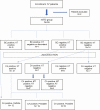Plasma Microbial Cell-free DNA Next-generation Sequencing in the Diagnosis and Management of Febrile Neutropenia
- PMID: 33870413
- PMCID: PMC9070798
- DOI: 10.1093/cid/ciab324
Plasma Microbial Cell-free DNA Next-generation Sequencing in the Diagnosis and Management of Febrile Neutropenia
Abstract
Background: Standard testing fails to identify a pathogen in most patients with febrile neutropenia (FN). We evaluated the ability of the Karius microbial cell-free DNA sequencing test (KT) to identify infectious etiologies of FN and its impact on antimicrobial management.
Methods: This prospective study (ClinicalTrials.gov; NCT02912117) enrolled and analyzed 55 patients with FN. Up to 5 blood samples were collected per subject within 24 hours of fever onset (T1) and every 2 to 3 days. KT results were compared with blood culture (BC) and standard microbiological testing (SMT) results.
Results: Positive agreement was defined as KT identification of ≥1 isolate also detected by BC. At T1, positive and negative agreement were 90% (9/10) and 31% (14/45), respectively; 61% of KT detections were polymicrobial. Clinical adjudication by 3 independent infectious diseases specialists categorized Karius results as: unlikely to cause FN (N = 0); definite (N = 12): KT identified ≥1 organism also found by SMT within 7 days; probable (N = 19): KT result was compatible with a clinical diagnosis; possible (N = 10): KT result was consistent with infection but not considered a common cause of FN. Definite, probable, and possible cases were deemed true positives. Following adjudication, KT sensitivity and specificity were 85% (41/48) and 100% (14/14), respectively. Calculated time to diagnosis was generally shorter with KT (87%). Adjudicators determined real-time KT results could have allowed early optimization of antimicrobials in 47% of patients, by addition of antibacterials (20%) (mostly against anaerobes [12.7%]), antivirals (14.5%), and/or antifungals (3.6%); and antimicrobial narrowing in 27.3% of cases.
Clinical trials registration: NCT02912117.
Conclusion: KT shows promise in the diagnosis and treatment optimization of FN.
Keywords: Febrile neutropenia; infection; next-generation sequencing.
© The Author(s) 2021. Published by Oxford University Press for the Infectious Diseases Society of America.
Figures



Comment in
-
Sequencing for Infection Diagnostics: Is It Time to embrace the Next Generation?Clin Infect Dis. 2022 May 3;74(9):1669-1670. doi: 10.1093/cid/ciab326. Clin Infect Dis. 2022. PMID: 33870419 No abstract available.
Similar articles
-
Clinical metagenomic sequencing of plasma microbial cell-free DNA for febrile neutropenia in patients with acute leukaemia.Clin Microbiol Infect. 2024 Jan;30(1):107-113. doi: 10.1016/j.cmi.2023.05.034. Epub 2023 Jun 2. Clin Microbiol Infect. 2024. PMID: 37271194
-
Metagenomic Next-generation Sequencing Compared With Blood Culture as First-line Diagnostic Method for Bloodstream Infection in Hematologic Patients With Febrile Neutropenia: A Multicenter, Prospective Study.Open Forum Infect Dis. 2025 May 16;12(6):ofaf288. doi: 10.1093/ofid/ofaf288. eCollection 2025 Jun. Open Forum Infect Dis. 2025. PMID: 40453877 Free PMC article.
-
Utility of Serial Microbial Cell-free DNA Sequencing for Inpatient and Outpatient Pathogen Surveillance Among Allogeneic Hematopoietic Stem Cell Transplant Recipients.Open Forum Infect Dis. 2024 Jul 3;11(8):ofae330. doi: 10.1093/ofid/ofae330. eCollection 2024 Aug. Open Forum Infect Dis. 2024. PMID: 39086465 Free PMC article.
-
Febrile neutropenia in hematologic malignancies.Curr Hematol Malig Rep. 2013 Dec;8(4):370-8. doi: 10.1007/s11899-013-0171-4. Curr Hematol Malig Rep. 2013. PMID: 23990311 Review.
-
[Fast identification of febrile neutropenia improves the outcome].Ugeskr Laeger. 2015 Aug 31;177(36):V03150240. Ugeskr Laeger. 2015. PMID: 26324292 Review. Danish.
Cited by
-
Analytical and clinical validation of direct detection of antimicrobial resistance markers by plasma microbial cell-free DNA sequencing.J Clin Microbiol. 2024 Oct 16;62(10):e0042524. doi: 10.1128/jcm.00425-24. Epub 2024 Aug 28. J Clin Microbiol. 2024. PMID: 39194269 Free PMC article.
-
The utility of disc space and vertebral body specimens cell count differential for the diagnosis of native vertebral osteomyelitis: a prospective cohort study.Eur J Clin Microbiol Infect Dis. 2024 Dec;43(12):2371-2381. doi: 10.1007/s10096-024-04951-3. Epub 2024 Oct 2. Eur J Clin Microbiol Infect Dis. 2024. PMID: 39356370
-
Fever and neutropenia in pediatric oncology and stem cell transplant patients: an editorial commentary on updated international clinical practice guidelines.Transl Pediatr. 2023 Oct 30;12(10):1908-1912. doi: 10.21037/tp-23-368. Epub 2023 Oct 20. Transl Pediatr. 2023. PMID: 37969121 Free PMC article. No abstract available.
-
Clinical impact of a metagenomic microbial plasma cell-free DNA next-generation sequencing assay on treatment decisions: a single-center retrospective study.BMC Infect Dis. 2022 Apr 13;22(1):372. doi: 10.1186/s12879-022-07357-8. BMC Infect Dis. 2022. PMID: 35418022 Free PMC article.
-
The Real-World Clinical Impact of Plasma mNGS Testing: an Observational Study.Microbiol Spectr. 2023 Mar 22;11(2):e0398322. doi: 10.1128/spectrum.03983-22. Online ahead of print. Microbiol Spectr. 2023. PMID: 36946733 Free PMC article.
References
-
- Klastersky J. Management of fever in neutropenic patients with different risks of complications. Clin Infect Dis 2004; 39(Suppl 1):S32–7. - PubMed
-
- de Naurois J, Novitzky-Basso I, Gill MJ, Marti FM, Cullen MH, Roila F; ESMO Guidelines Working Group . Management of febrile neutropenia: ESMO Clinical Practice Guidelines. Ann Oncol 2010; 21(Suppl 5):v252–6. - PubMed
-
- Montoya JG, Multani A. Diagnosis of infection in immunocompromised patients: from microscopy to next generation sequencing and host gene signatures. Curr. Opin. Infect. Dis. 2019; 32:295–9. - PubMed
Publication types
MeSH terms
Substances
Associated data
LinkOut - more resources
Full Text Sources
Other Literature Sources
Medical
Miscellaneous

